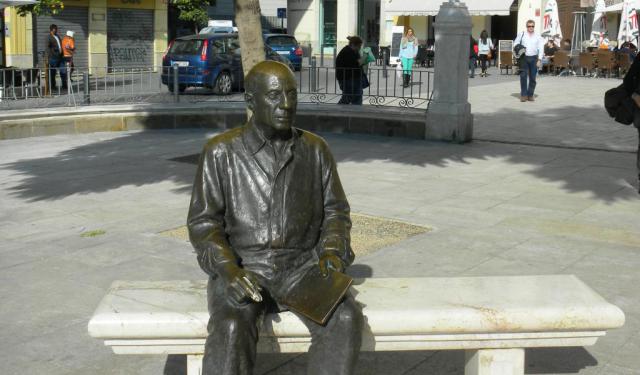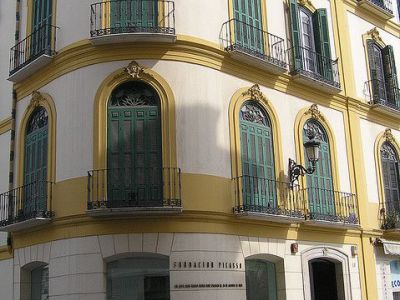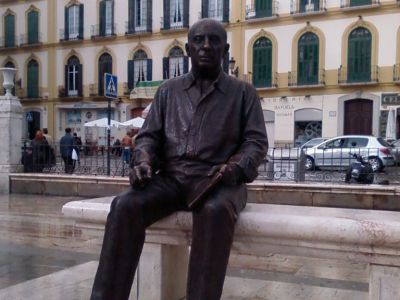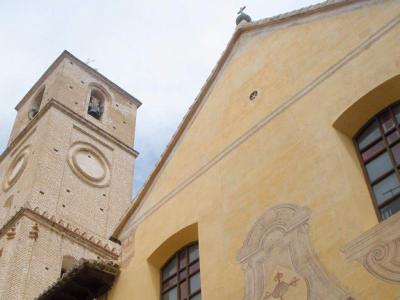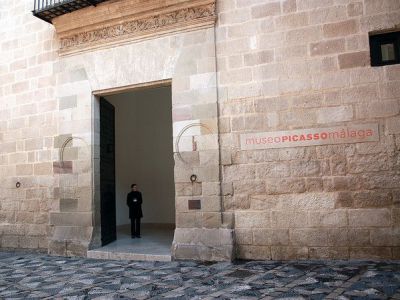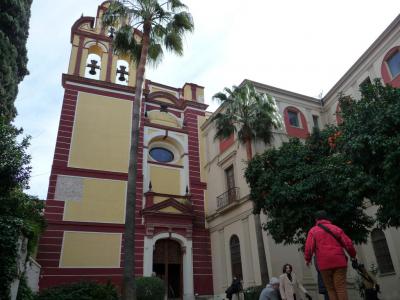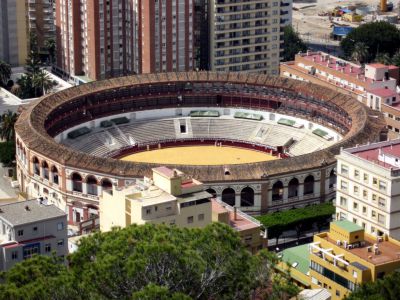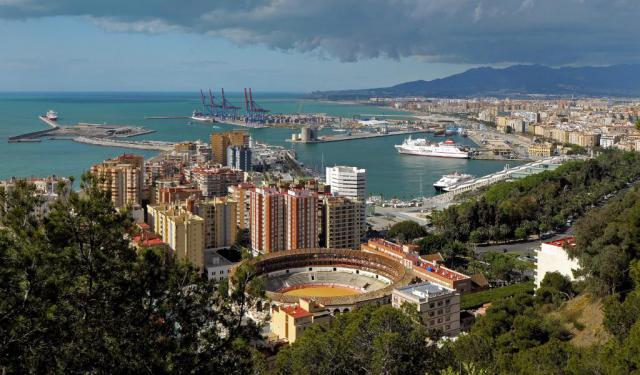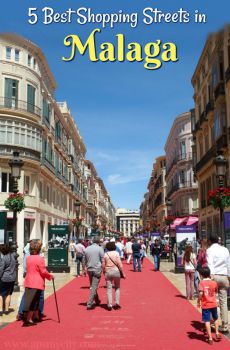Pablo Picasso's Malaga (Self Guided), Malaga
Among other things for which Malaga has gone down in history is being the town where Pablo Picasso, the famous painter and innovator of the Cubist movement, was born and spent his early childhood. The milieu and the daily life of those years inspired some of Picasso’s most characteristic subjects in paintings, such as flamenco, doves and bulls.
The best place to start a walk through Picasso’s Malaga is Casa Natal at Plaza de la Merced, 15. Today this boyhood home of Picasso houses his Foundation and Birthplace Museum containing furnishing and personal effects of the Picasso family, as well as a notable art collection featuring works by Picasso and over 200 other artists, including his contemporaries. Just a few steps away, in the adjacent square, you will find the life-size bronze statue of Picasso – Estatua de Pablo Ruiz Picasso – seated on a marble bench.
The next stop on the trip may be the Church of Santiago Apostol, where Pablo Picasso was baptized. You will also want to visit the larger Picasso Museum at Calle San Agustín, 8 – the live realization of the artist’s desire to have his work displayed in the native town. At the end of this street is another church, of San Agustín, the former municipal archive and museum of Malaga, where Pablo's father served as the curator and had a studio; Picasso had vivid memories of this place.
The last stop on the tour is the bullring, La Malagueta. Picasso's father often brought him here, as a child, to see the leading bullfighters of the day. It was here that Picasso developed a lifelong passion for bullfighting.
If you wish to see the places that once shaped the genius of Pablo Picasso in his home town, take this self-guided tour.
The best place to start a walk through Picasso’s Malaga is Casa Natal at Plaza de la Merced, 15. Today this boyhood home of Picasso houses his Foundation and Birthplace Museum containing furnishing and personal effects of the Picasso family, as well as a notable art collection featuring works by Picasso and over 200 other artists, including his contemporaries. Just a few steps away, in the adjacent square, you will find the life-size bronze statue of Picasso – Estatua de Pablo Ruiz Picasso – seated on a marble bench.
The next stop on the trip may be the Church of Santiago Apostol, where Pablo Picasso was baptized. You will also want to visit the larger Picasso Museum at Calle San Agustín, 8 – the live realization of the artist’s desire to have his work displayed in the native town. At the end of this street is another church, of San Agustín, the former municipal archive and museum of Malaga, where Pablo's father served as the curator and had a studio; Picasso had vivid memories of this place.
The last stop on the tour is the bullring, La Malagueta. Picasso's father often brought him here, as a child, to see the leading bullfighters of the day. It was here that Picasso developed a lifelong passion for bullfighting.
If you wish to see the places that once shaped the genius of Pablo Picasso in his home town, take this self-guided tour.
How it works: Download the app "GPSmyCity: Walks in 1K+ Cities" from Apple App Store or Google Play Store to your mobile phone or tablet. The app turns your mobile device into a personal tour guide and its built-in GPS navigation functions guide you from one tour stop to next. The app works offline, so no data plan is needed when traveling abroad.
Pablo Picasso's Malaga Map
Guide Name: Pablo Picasso's Malaga
Guide Location: Spain » Malaga (See other walking tours in Malaga)
Guide Type: Self-guided Walking Tour (Sightseeing)
# of Attractions: 6
Tour Duration: 1 Hour(s)
Travel Distance: 1.3 Km or 0.8 Miles
Author: HelenF
Sight(s) Featured in This Guide:
Guide Location: Spain » Malaga (See other walking tours in Malaga)
Guide Type: Self-guided Walking Tour (Sightseeing)
# of Attractions: 6
Tour Duration: 1 Hour(s)
Travel Distance: 1.3 Km or 0.8 Miles
Author: HelenF
Sight(s) Featured in This Guide:
- Picasso Birthplace Museum
- Estatua de Pablo Ruiz Picasso (Picasso Sculpture)
- Iglesia de Santiago Apóstol (Church of Santiago)
- Museo Picasso Málaga (Picasso Museum)
- Convento de San Agustín de Málaga (San Agustín Convent)
- Plaza de Toros de La Malagueta (La Malagueta Bullring)
1) Picasso Birthplace Museum
It was inevitable that Malaga should produce Picasso. The first ten years of his life there nourished his talent. He was born at number 15 Plaza de la Merced (Merced Square), a building now known as the Casa Natal. Elements of Malaga's rich history surround the house. Everyday life in Malaga provided recurrent themes of his art.
The building was erected in 1861. Picasso's father, Jose Ruiz Blasco rented the first floor of the house from 1880 to 1883. In 1983 it was declared a Historic-Artistic Monument of National Interest. In 1998 the building was taken over by the Picasso Foundation and officially reopened by the King and Queen of Spain.
On the ground floor is an exhibition hall showing items from Picasso's early family life and works by both Picasso and his father. The first floor holds works on exhibit by the artist. The third floor contains the library and Research Center and an extensive archive of material regarding the artist and his oeuvre.
Along with Picasso's prints, ceramics and graphic art pieces there are 3,500 works by 200 other artists. It is a vast selection representing Miro, Christo, Bacon, Brossa, Ernst and others including Malaga artists from the 1950s to the present.
Tip:
Admission is free every Sunday from 4pm.
The building was erected in 1861. Picasso's father, Jose Ruiz Blasco rented the first floor of the house from 1880 to 1883. In 1983 it was declared a Historic-Artistic Monument of National Interest. In 1998 the building was taken over by the Picasso Foundation and officially reopened by the King and Queen of Spain.
On the ground floor is an exhibition hall showing items from Picasso's early family life and works by both Picasso and his father. The first floor holds works on exhibit by the artist. The third floor contains the library and Research Center and an extensive archive of material regarding the artist and his oeuvre.
Along with Picasso's prints, ceramics and graphic art pieces there are 3,500 works by 200 other artists. It is a vast selection representing Miro, Christo, Bacon, Brossa, Ernst and others including Malaga artists from the 1950s to the present.
Tip:
Admission is free every Sunday from 4pm.
2) Estatua de Pablo Ruiz Picasso (Picasso Sculpture)
The sculpture Portrait of the Painter Pablo Picasso is a bronze statue depicting the artist seated on a marble bench, with a notebook and a pencil in hands. Almost life-size (the sculptured figure is a bit bigger than Picasso's real stature), this monument was created by Francisco López Hernández and inaugurated on December 5, 2008.
It is located just a few steps away from Picasso's birthplace, Casa Natal, at 15 Plaza de la Merced, which now a museum and a home to the headquarters of the Picasso Foundation.
Ever since its installation, the statue of Pablo has been involved in numerous performances held in the square, such as the White Night, running since 2009, during which, depending on the theme, it is decorated in one way or another.
In April 2013, a group of vandals attempted to steal the statue. However, because of its heavy weight, they could not take it very far and left it on a nearby bench.
Presently, the bronze Picasso is back in his place, leaving sufficient space on the bench to sit next to him and have a little chitchat, or take a memorable photo.
It is located just a few steps away from Picasso's birthplace, Casa Natal, at 15 Plaza de la Merced, which now a museum and a home to the headquarters of the Picasso Foundation.
Ever since its installation, the statue of Pablo has been involved in numerous performances held in the square, such as the White Night, running since 2009, during which, depending on the theme, it is decorated in one way or another.
In April 2013, a group of vandals attempted to steal the statue. However, because of its heavy weight, they could not take it very far and left it on a nearby bench.
Presently, the bronze Picasso is back in his place, leaving sufficient space on the bench to sit next to him and have a little chitchat, or take a memorable photo.
3) Iglesia de Santiago Apóstol (Church of Santiago)
The Church of Santiago Apostol (Iglesia de Santiago) is Malaga’s oldest church, established in 1490 shortly after the Christian conquest of the city in 1487. Originally constructed as one of the four parishes ordered by the Catholic Monarchs, it briefly served as Malaga’s Cathedral until work on the current cathedral was completed. The church is an exquisite blend of Gothic-Mudejar and Baroque styles, embodying the cultural fusion of Christian conquerors and the legacy of the Islamic population.
The church’s colorful facade and Mudejar-style central door are striking features, remnants of its incorporation of an adjoining mosque. The square tower, originally constructed as a minaret and later integrated with the church in the 16th century, showcases Almohad sebka motifs, a reminder of its Islamic heritage. Inside, the church boasts three naves adorned with significant artworks by renowned Baroque painters Alonso Cano and Niño de Guevara. Among its treasures is a 16th-century plateresque-style chalice with a star-shaped foot and hexagonal body.
The Church of Santiago holds a special place in Malaga’s religious and cultural history. It is closely tied to the city’s Semana Santa celebrations, housing chapels with venerated processional images such as Virgen del Amor and Jesus el Rico, known for the annual tradition of releasing a prisoner during Holy Week. The Christ of Medinaceli, a 17th-century icon, draws devotees each March's first Friday, offering three coins in homage.
The church is also renowned as the baptismal site of Pablo Picasso on November 10, 1881. A commemorative plaque on the facade marks this historic event, and his baptismal certificate is preserved within the church.
Nestled in the bustling historic center of Malaga, the Church of Santiago is a testament to the city’s rich history and cultural layers. Visitors can admire its unique architecture, steeped in centuries of history, and discover its artistic and spiritual treasures.
The church’s colorful facade and Mudejar-style central door are striking features, remnants of its incorporation of an adjoining mosque. The square tower, originally constructed as a minaret and later integrated with the church in the 16th century, showcases Almohad sebka motifs, a reminder of its Islamic heritage. Inside, the church boasts three naves adorned with significant artworks by renowned Baroque painters Alonso Cano and Niño de Guevara. Among its treasures is a 16th-century plateresque-style chalice with a star-shaped foot and hexagonal body.
The Church of Santiago holds a special place in Malaga’s religious and cultural history. It is closely tied to the city’s Semana Santa celebrations, housing chapels with venerated processional images such as Virgen del Amor and Jesus el Rico, known for the annual tradition of releasing a prisoner during Holy Week. The Christ of Medinaceli, a 17th-century icon, draws devotees each March's first Friday, offering three coins in homage.
The church is also renowned as the baptismal site of Pablo Picasso on November 10, 1881. A commemorative plaque on the facade marks this historic event, and his baptismal certificate is preserved within the church.
Nestled in the bustling historic center of Malaga, the Church of Santiago is a testament to the city’s rich history and cultural layers. Visitors can admire its unique architecture, steeped in centuries of history, and discover its artistic and spiritual treasures.
4) Museo Picasso Málaga (Picasso Museum) (must see)
Pablo Picasso's father, Jose Ruiz, was the curator of the city museum of Malaga. The museum was not often open to the public because of limited budgets. Part of Jose's compensation was the exclusive use of a room in the building as an art studio. Pablo did his first sketches in that room, working with his father.
Now Picasso has a museum in Paris, and another in Barcelona. He has several of them but the Picasso Museum in Malaga is close to home. Six hundred feet away from the Picasso Museum is the Merced Square where he was born. In 2003 the Picasso Museum had its grand opening with the King and Queen of Spain in attendance.
The Buenavista Palace that housed the museum was built in the 16th century. It was built for one Diego de Cazalla. Under the Palace were the remains of a Nasrid palace which have partially survived.
The 20th century conversion of the dilapidated palace into a museum was a challenging project led by architect Richard Gluckman. The palace alone was not large enough to accommodate all the functions of a proper museum. It was necessary to acquire two neighboring houses that had fallen into disrepair.
Christine Picasso, widow of the artist's eldest son Paulo Ruiz-Picasso, and her son Bernard have donated 155 of Picasso's works to the Museum. The collection includes early studies in Cubism and his later re-doing of Old Masters. Additional pieces are on loan. There are documents, photos and a library with nearly a thousand titles devoted to Picasso.
Tip:
It is possible to get in for free on a Sunday at noon but be aware the queues can be huge and the wait is long.
Now Picasso has a museum in Paris, and another in Barcelona. He has several of them but the Picasso Museum in Malaga is close to home. Six hundred feet away from the Picasso Museum is the Merced Square where he was born. In 2003 the Picasso Museum had its grand opening with the King and Queen of Spain in attendance.
The Buenavista Palace that housed the museum was built in the 16th century. It was built for one Diego de Cazalla. Under the Palace were the remains of a Nasrid palace which have partially survived.
The 20th century conversion of the dilapidated palace into a museum was a challenging project led by architect Richard Gluckman. The palace alone was not large enough to accommodate all the functions of a proper museum. It was necessary to acquire two neighboring houses that had fallen into disrepair.
Christine Picasso, widow of the artist's eldest son Paulo Ruiz-Picasso, and her son Bernard have donated 155 of Picasso's works to the Museum. The collection includes early studies in Cubism and his later re-doing of Old Masters. Additional pieces are on loan. There are documents, photos and a library with nearly a thousand titles devoted to Picasso.
Tip:
It is possible to get in for free on a Sunday at noon but be aware the queues can be huge and the wait is long.
5) Convento de San Agustín de Málaga (San Agustín Convent)
The Convent of Saint Augustin is located on the Calle San Augustin in Malaga. This is Picasso's neighborhood. The convent is next to the Palacio de Buenavista and the Picasso Museum. It was built on land purchased by the Augustinian Friars in 1575. The street at that time was called Calle de los Caballeros.
In 1810 the convent was damaged by the French invasion and it did not resume activities until 1812. This was at the height of Napoleon's busy time. During the years that followed the convent was a city hall, then a blood hospital, then a seminary. After all that shuffling, it became an Augustinian school in 1918.
The convent was familiar to Picasso. His father was curator of paintings that were exhibited in the town hall. The school allowed his father the use of a workshop as a studio where he taught art. The teacher recalled the workshop was nothing special. "A little dirtier...than the one I had at home; but it was quiet..."
In 1810 the convent was damaged by the French invasion and it did not resume activities until 1812. This was at the height of Napoleon's busy time. During the years that followed the convent was a city hall, then a blood hospital, then a seminary. After all that shuffling, it became an Augustinian school in 1918.
The convent was familiar to Picasso. His father was curator of paintings that were exhibited in the town hall. The school allowed his father the use of a workshop as a studio where he taught art. The teacher recalled the workshop was nothing special. "A little dirtier...than the one I had at home; but it was quiet..."
6) Plaza de Toros de La Malagueta (La Malagueta Bullring)
La Malagueta, the bullring of Malaga, can be found in the center of the city, near the Paseo de Reding. The structure of the arena is in the style of neomudejar in the shape of a hexadecagon (16 sides). The ring measures 169 feet in diameter. It has holding pens, stables, dressing rooms, and most importantly, a first aid post.
La Malagueta hosts events during the fighting season, including two fights in Holy Week. One of the fights is named Corrida Picassiana for Pablo Picasso. When Picasso was a child, his father often brought him here to watch bullfights. It was here Picasso developed a lifelong passion for bullfighting.
The contest between man and bull appears often in Picasso's sketches and paintings. In a 1925 painting of his son Paul, the child was dressed in the traditional costume of a bullfighter with the red cape in one hand. In the background, one can see the subtle outline of a bullring arena.
The bullring has a season from April to September. It is a short walk from Malagueta beach in the eastern part of the old town. The best view of the ring is from the Castle of Gibralfaro, above the Malaga Fortress.
La Malagueta hosts events during the fighting season, including two fights in Holy Week. One of the fights is named Corrida Picassiana for Pablo Picasso. When Picasso was a child, his father often brought him here to watch bullfights. It was here Picasso developed a lifelong passion for bullfighting.
The contest between man and bull appears often in Picasso's sketches and paintings. In a 1925 painting of his son Paul, the child was dressed in the traditional costume of a bullfighter with the red cape in one hand. In the background, one can see the subtle outline of a bullring arena.
The bullring has a season from April to September. It is a short walk from Malagueta beach in the eastern part of the old town. The best view of the ring is from the Castle of Gibralfaro, above the Malaga Fortress.
Walking Tours in Malaga, Spain
Create Your Own Walk in Malaga
Creating your own self-guided walk in Malaga is easy and fun. Choose the city attractions that you want to see and a walk route map will be created just for you. You can even set your hotel as the start point of the walk.
Malaga Introduction Walking Tour
Malaga is old. It is 2,800 years old. It is thought to have been founded by Phoenician traders in 770 BC. From its beginnings, it was a natural waypoint between Phoenicia in the eastern Mediterranean and Gibraltar. Cathaginians and, later, Romans ruled the city. Their core settlements were in an area between Gibralfaro Hill to the Guadalmedina River.
From the eighth century to the end of the... view more
Tour Duration: 2 Hour(s)
Travel Distance: 3.4 Km or 2.1 Miles
From the eighth century to the end of the... view more
Tour Duration: 2 Hour(s)
Travel Distance: 3.4 Km or 2.1 Miles
Architectural Jewels of Malaga
The blooming port city of Málaga has a wealth of architecture with no shortage of ancient and otherwise impressive buildings fit to vow any visitor. Having witnessed the fall and rise of many civilizations, Malaga's uniqueness is marked by the variety of architectural styles, upon which the times past had a great deal of impact. From its stunning Moorish fortress – the best-preserved of... view more
Tour Duration: 2 Hour(s)
Travel Distance: 3.7 Km or 2.3 Miles
Tour Duration: 2 Hour(s)
Travel Distance: 3.7 Km or 2.3 Miles
Useful Travel Guides for Planning Your Trip
5 Best Shopping Streets in Malaga, Spain
As well as one of the best cultural destinations in southern Spain, Malaga turns out to be something of a shopping mecca. Along with the ubiquitous shopping malls on the outskirts, the capital of Costa del Sol has managed to preserve its network of specialist shops, difficult to find in most big...
The Most Popular Cities
/ view all
